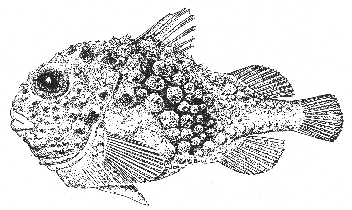Spiny lumpfish Eumicrotremus spinosus (Müller) 1777
[Jordan and Evermann, 1896-1900, p. 2098.]

Figure 242.—Spiny lumpfish (Eumicrotremus spinosus) Massachusetts Bay specimen. From Goode and Bean. Drawing by H. L. Todd.
Description—
The spiny lumpfish is easily distinguishable from its commoner relative by the fact that its skin tubercles are not only much larger relatively, and studded from the base to the tip with rough prickles, but are irregularly and closely scattered over the body and head. Furthermore, its gill openings are much shorter, while its body is not so high-arched, and is nearly round in cross section, instead of triangular. Also, its first dorsal (though fleshy in some of them) retains its fin-like appearance through life, instead of becoming entirely concealed by the skin.
Color—
Described as olivaceous to brownish.
General Range—
Arctic and northern parts of the Atlantic Ocean, south to the Gulf of Maine as a stray.
Occurrence in the Gulf of Maine—
Stray specimens of this northern fish have been reported from Eastport, Maine; from off Cape Ann; and from Salem, in the north side of Massachusetts Bay. We have also seen three small specimens, 1-1¼ inches long that were collected about 15 miles southeast of Cape Ann in 23 and 29 fathoms, by the U. S. Fish Commission in 1878 (now in the U. S, National Museum.)[40]
[40] Myers and Bohlke (Stanford Ichth. Bull., vol. 3, No. 4, 1950, p. 199) have described a new species of spiny lumpfish (E. terrae-novae) from Newfoundland. But the specimens from off Salem and from off Eastport pictured by Goode and Bean (Smithsonian Contrib. Knowl., vol. 31, 1895, pl. 70, fig. 250) and by Garman (Mem. Mus. Comp. Zool., vol. 14, 1892, p. 71, figs. 1-3) were typical spinosus, as are the three small ones, from about 15 miles southeast of Cape Ann, that are mentioned above.